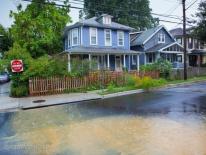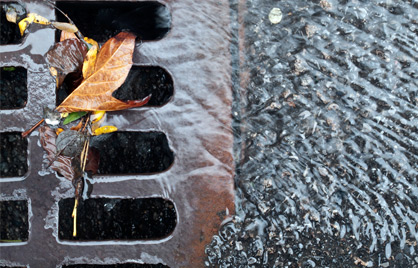
What is stormwater?
Stormwater is excessive rainfall that does not soak into the ground, but instead flows over the land’s hard surface into the nearest water body through storm drain channels.
Why is stormwater a problem?
Undeveloped or grassy areas, such as parks and lawns, soak up most of the rain that falls there. Therefore, there is much more polluted stormwater runoff in areas with large amounts of impervious, or non-porous, surfaces. Stormwater from urban areas is one type of 'nonpoint source' pollution - pollution that comes from many diffuse sources. The stormwater picks up all the pollutants along its pathway. Because polluted stormwater runoff is caused by so many of our everyday activities, we all need to work together to prevent it!
Many of these pollutants can cause problems in very small amounts. The cumulative effects of stormwater runoff on water bodies are evident in both of our rivers and in Rock Creek. The Potomac and Anacostia Rivers, that regularly receive untreated stormwater, now suffer from poor water quality. Pollutants in stormwater may include antifreeze, grease, oil, and heavy metals from cars; fertilizers, pesticides and other chemicals from gardens, homes and businesses; bacteria from pet wastes and failing septic systems; and sediment from poor construction site practices. If not properly managed, the volume of stormwater can flood and damage homes and businesses, flood septic system drainfields, erode stream channels, and damage or destroy fish and wildlife habitat. Because less water soaks into the ground, drinking water supplies are not replenished and streams and wetlands are not recharged. This can lead to water shortages for people and inadequate stream flows for fish.
Uncontrolled stormwater runoff has many cumulative impacts on humans and the environment including:
- Flooding - Damage to public and private property
- Eroded Streambanks - Sediment clogs waterways, fills lakes, reservoirs, kills fish and aquatic animals
- Widened Stream Channels - Loss of valuable property
- Aesthetics - Dirty water, trash and debris, foul odors
- Fish and Aquatic Life - Impaired and destroyed
- Impaired Recreational Uses - Swimming, fishing, boating
- Threatens Public Health - Contamination of drinking water, fish/shellfish
- Threatens Public Safety - Drownings occur in flood waters
- Economic Impacts – Impairments to fisheries, shellfish, tourism, recreation related businesses
- Increased Cost of Water and Wastewater Treatment - Stormwater pollution increases raw water treatment costs and reduces the assimilative capacity of waterbodies.
DOEE engages in many activities to reduce stormwater pollution, including implementing and enforcing the District’s municipal separate storm sewer system (MS4) Permit, Stormwater regulations, Stormwater Retention Credit Trading Program, and Stormwater Guidebook.
DOEE has programs to expand the District’s tree canopy, reduce litter and illegal dumping, install innovative stormwater management projects, increase community participation, and restore Districts streams, wetlands, and habitat.
- Watershed Protection Programs
- Environmental Education
- Trash and Litter Reduction Programs
- Tree Canopy
- Wards 7 & 8 Engagement Strategy for MS4 Permit Programs
How can the public help reduce stormwater pollution?
There are a variety of avenues for District residents to help reduce stormwater pollution. If you are a homeowner, consider installing green infrastructure on your property through the RiverSmart Homes program. If you volunteer or work with a non-profit organization or belong to a house of worship, you can apply to the RiverSmart Communities grant program. If you’re excited to clean up your neighborhood by picking up litter, adopt a block, a nearby park, or a local stream. Are you simply interested in learning more about the District’s waterways and how stormwater pollution occurs, participate in the Watershed Stewards Academy.
Stormwater Management FAQs
Below are answers to frequently asked questions regarding Stormwater Management.
What is stormwater pollution?
Stormwater pollution comes directly from runoff during a storm event. This water can runoff of roof tops, driveways, parking lots, yards, and streets. During this event, water picks up many of the pollutants that are already on these surfaces, such as toxic metals, pesticides, fertilizers, vehicle oils, dirt particles, trash and leaves. The water, and all its pollutants, travels to the local storm sewer and into local rivers, streams, and eventually into the Chesapeake Bay.
How can I prevent stormwater pollution at home?
Reducing stormwater pollution at home is easy! Place rain barrels to collect water for plants and gardens. You can build a beautiful rain garden that allows storm water to flow into the ground rather than into the storm drain. You can disconnect your gutter downspout to redirect it into your yard or garden, rather than into the street or driveway.
What's the big deal about stormwater in the District?
Under federal law, the District is required to control its storm water that enters the local watersheds (Potomac, Anacostia) and reduce the amounts of pollutants that the stormwater contains. District agencies (DOEE, DPW, DDOT, WASA) are actively involved in developing practices that reduce pollutants at the source, long before they enter critical water bodies.
Where can I properly dispose of household hazardous wastes?
Every year, there are weekly drop offs for your household hazardous wastes (paint, fertilizers, pesticides, mercury thermometers, automobile oil, unknowns, etc). For more information visit the DPW website for specific dates and times.

